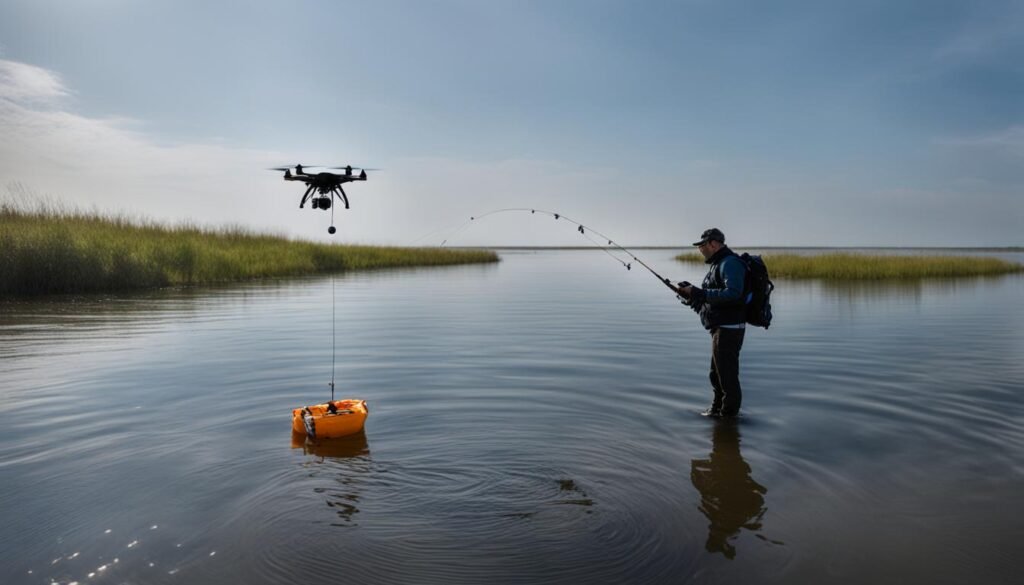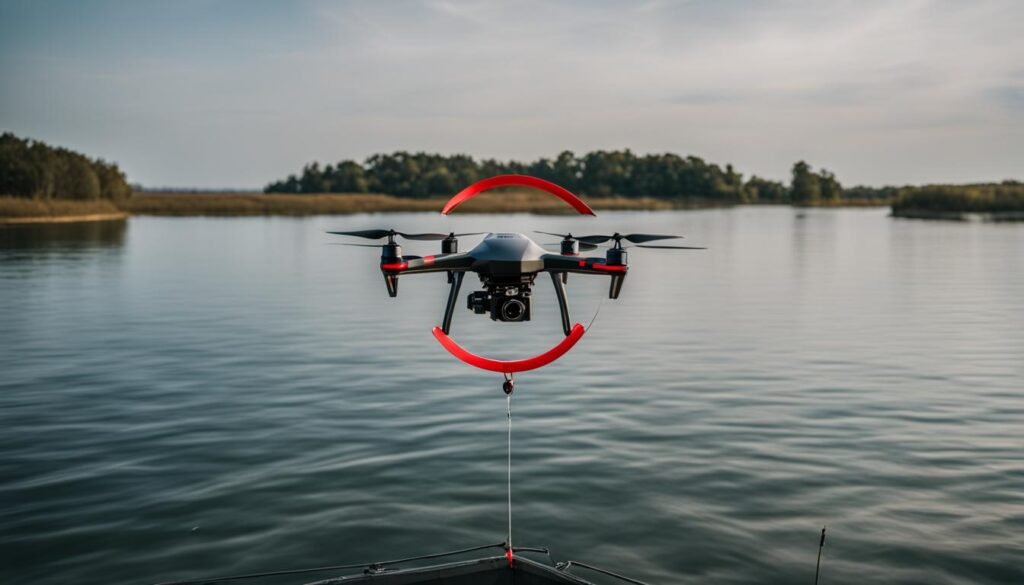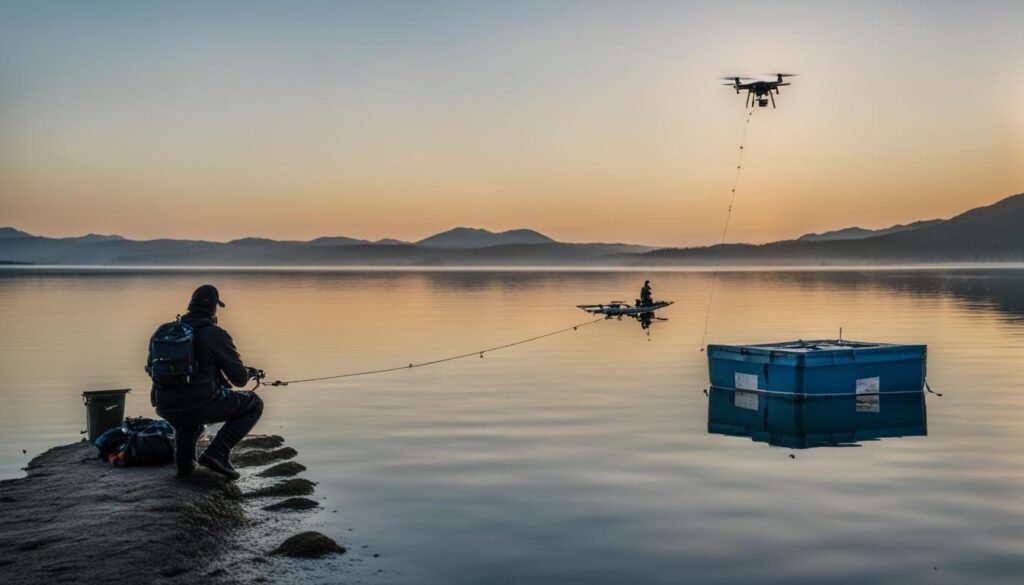Fishing is a fulfilling activity that offers stress relief, social bonding, and numerous health benefits. While traditional methods of fishing involve rods and nets, drone fishing has emerged as a new and useful technique. With the right drone and bait-release mechanism, you can cast your line from the shore and reach greater distances in the sea. Drone fishing provides several benefits and challenges, and there are various techniques and considerations to keep in mind when using drones for bait delivery.
Drone fishing allows you to experience the thrill of casting your bait farther than ever before, opening up new fishing opportunities and increasing your chances of success. By utilizing the advanced GPS technology and camera capabilities of drones, you can pinpoint areas with a high concentration of fish and strategically drop your bait for maximum effectiveness. This innovative approach to fishing allows you to cover greater distances while staying on land, saving you the time and effort of setting up a boat.
The History of Drone Fishing
The concept of drone fishing is relatively new, but it has quickly gained popularity in recent years. Let’s take a closer look at the history of drone fishing and the pioneers who paved the way for this innovative technique.
Derek Klingenberg, a well-known farmer and drone enthusiast, is often credited as one of the pioneers of drone fishing. In 2015, Klingenberg recorded a video showcasing his fishing skills using a DJI Phantom drone and a hook and line. His video captured the attention of fishing enthusiasts and sparked interest in the potential of drones for fishing.
However, it was later discovered that another individual, David Darg, recorded a similar video in 2013. Darg, a filmmaker and adventurer, used a drone to catch fish in remote areas. Both Klingenberg and Darg improvised their techniques and showcased the possibilities of using drones for fishing purposes.
Since then, the popularity of drone fishing has continued to grow, leading to the development of specialized drones and accessories specifically designed for fishing. Anglers around the world have embraced this technique as a way to reach greater distances and explore new fishing spots.
What Is Drone Fishing?

Drone fishing is an innovative technique that revolutionizes the way anglers cast and bring fish closer to the shore. This exciting method utilizes a drone equipped with advanced features such as GPS navigation, a camera, and a bait-delivery mechanism. By leveraging these capabilities, drone fishing enthusiasts can take their fishing experience to new heights.
With the help of drone GPS, anglers can precisely navigate their drones to desired fishing spots. The built-in camera provides a remote view of the water, enabling anglers to easily spot areas with a high concentration of fish. Once a promising location is identified, the bait-delivery mechanism attached to the drone can be activated, releasing your bait precisely where the fish are biting.
The advantages of drone fishing are abundant. Firstly, drones allow you to cast your line up to 500 meters into the sea, surpassing the distance achievable by traditional fishing methods from the shore. This extended reach opens up new opportunities and potentially increases your chances of a successful catch. Furthermore, drone fishing eliminates the need for a boat, minimizing costs and offering a more accessible fishing experience.
Maintenance is also simplified with drones. Traditional fishing boats require regular upkeep, maintenance costs, and storage arrangements. In contrast, drones are relatively easy to maintain, with fewer moving parts to service and store. This convenience allows anglers to focus on their fishing experience rather than worrying about the maintenance of a larger vessel.
Rules and Regulations

When it comes to drone fishing, it is crucial to abide by the rules and regulations set by authorities. These regulations ensure the safety of the public and protect the environment. Familiarizing yourself with the drone fishing regulations in your specific location is essential to avoid any legal trouble and to responsibly enjoy this exciting hobby.
While drone fishing regulations may vary from state to state, there are some common restrictions that you should be aware of:
- Federal Building Restrictions: It is illegal to fly your drone over federal buildings. This restriction is in place to maintain the security and privacy of these facilities.
- Flying over People: To prevent potential harm or accidents, it is generally prohibited to fly your drone directly over people, especially in crowded public areas. Always ensure that you operate your drone in a safe and controlled environment.
- Weight Limit: Most states have a weight limit for drones used in recreational activities, including drone fishing. Typically, the weight limit is around 55 pounds. It is important to adhere to this limit to ensure the safety of both your drone and the people around you.
- Altitude Limit: To avoid interfering with airspace regulations and the flight paths of other aircraft, there is usually an altitude limit for drones. In most cases, the altitude limit for recreational drone use does not exceed 400 feet.
- Line of Sight: It is crucial to maintain visual line of sight with your drone while operating it. This regulation ensures that you have full control and awareness of your drone’s movements, minimizing the risk of accidents or loss of control.
It is worth noting that these regulations are subject to change, so it is important to stay informed about any updates or additions to the rules. Additionally, it is advisable to contact local authorities or drone associations in your area to obtain the most accurate and up-to-date information regarding drone fishing regulations.
How to Choose the Best Drone for Fishing?
When it comes to drone fishing, selecting the right drone is essential to optimize your fishing experience. There are several key features to consider when choosing a drone for fishing.
Camera Quality: A high-resolution camera is crucial for spotting fishing areas effectively. Look for drones with advanced camera technology that can capture clear images even from a distance. This will enable you to identify potential fishing hotspots and improve your chances of success.
Battery Life: Longer flight times mean extended fishing sessions. Look for drones with extended battery life to maximize your time on the water. This will allow you to cover more ground and increase your chances of landing the big catch.
Carrying Capacity: Consider the carrying capacity of the drone, as it determines the size and weight of the bait and tackle you can use. Choose a drone with a sufficient lifting capability to accommodate larger bait and tackle loads. This will ensure you have the necessary equipment to attract and reel in your target fish.
Range: The range of the drone’s transmission signal is a crucial factor to consider. It determines how far the drone can travel and reach your desired fishing locations. Look for drones with a long transmission range to explore larger areas and increase your chances of finding productive fishing spots.
By carefully evaluating these fishing drone features – camera quality, battery life, carrying capacity, and range – you can select the best drone that suits your fishing needs. Remember, the right drone can greatly enhance your fishing experience by providing the technology and capabilities to maximize your chances of success on the water.

